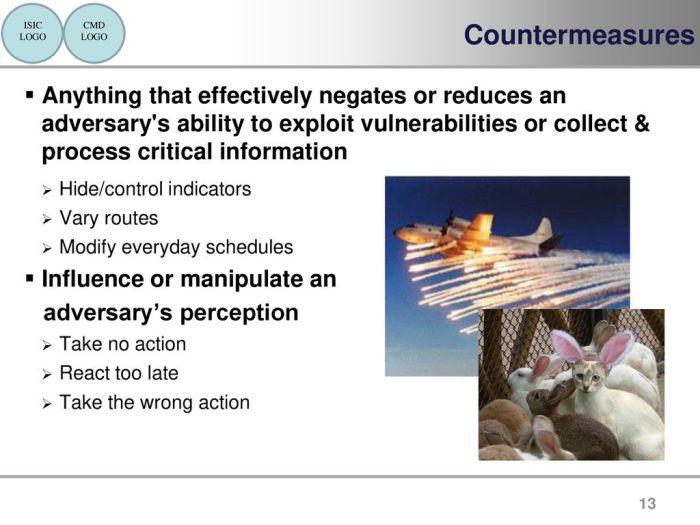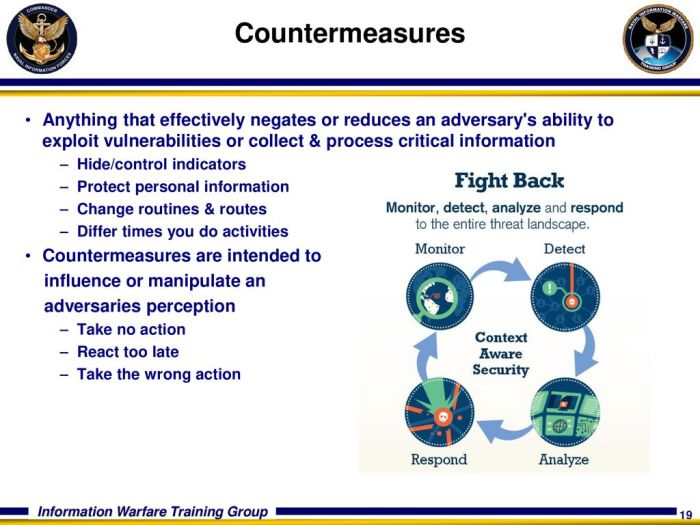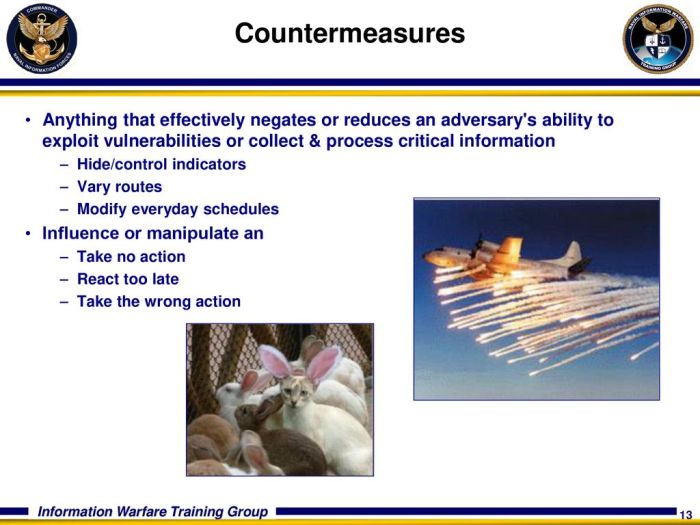Countermeasures control or hide and reduce vulnerabilities – In the ever-evolving landscape of cybersecurity, countermeasures to control, hide, and reduce vulnerabilities are paramount. This comprehensive guide delves into the multifaceted nature of vulnerability management, providing a roadmap for organizations to safeguard their systems against malicious actors.
Vulnerabilities are inherent weaknesses in software, hardware, or network configurations that can be exploited by attackers to gain unauthorized access, disrupt operations, or steal sensitive data. By implementing effective countermeasures, organizations can mitigate these risks and enhance their overall security posture.
Countermeasures for Vulnerability Control

Vulnerability control is a critical aspect of cybersecurity that involves identifying, prioritizing, and mitigating vulnerabilities in systems and applications. By implementing effective countermeasures, organizations can significantly reduce the risk of successful cyberattacks and protect their valuable assets.
Types of Countermeasures
- Technical Countermeasures:These include firewalls, intrusion detection systems, and antivirus software that detect and block malicious activities.
- Administrative Countermeasures:These involve implementing security policies, procedures, and guidelines to ensure proper system configuration and user behavior.
- Operational Countermeasures:These include regular security audits, vulnerability assessments, and patch management to identify and address vulnerabilities promptly.
Implementation of Countermeasures
Implementing effective countermeasures requires a comprehensive approach that includes:
- Identifying vulnerabilities through regular scanning and assessment.
- Prioritizing vulnerabilities based on their potential impact and likelihood of exploitation.
- Selecting and implementing appropriate countermeasures based on the nature of the vulnerability.
- Monitoring and evaluating the effectiveness of countermeasures to ensure ongoing protection.
Techniques for Hiding and Reducing Vulnerabilities

In addition to implementing countermeasures, organizations can also employ techniques to hide or reduce the impact of vulnerabilities.
Hiding Vulnerabilities
- Obfuscation:Modifying code or data to make it less readable or understandable to attackers.
- Honey Pots:Decoy systems that lure attackers away from real systems.
- Address Space Layout Randomization (ASLR):Randomizing the memory layout of applications to make it harder for attackers to exploit known vulnerabilities.
Reducing Impact of Vulnerabilities
- Least Privilege Principle:Granting users only the minimum permissions necessary to perform their tasks.
- Compartmentalization:Dividing systems into smaller, isolated segments to limit the spread of attacks.
- Sandboxing:Running applications in a restricted environment to prevent them from accessing critical resources.
| Technique | Advantages | Disadvantages |
|---|---|---|
| Obfuscation | Makes vulnerabilities harder to detect | Can be bypassed with advanced analysis techniques |
| Honey Pots | Attracts attackers and provides valuable information | Can be expensive and time-consuming to maintain |
| ASLR | Protects against memory-based attacks | Can slow down application performance |
| Least Privilege Principle | Limits the damage caused by successful attacks | Can be difficult to implement in complex systems |
| Compartmentalization | Prevents attacks from spreading | Can create communication and management challenges |
| Sandboxing | Protects critical resources from compromised applications | Can limit application functionality and performance |
Best Practices for Vulnerability Management

Effective vulnerability management requires a proactive and comprehensive approach.
Best Practices
- Regular Vulnerability Scanning and Patching:Regularly scanning systems for vulnerabilities and applying patches promptly is essential for minimizing the risk of successful attacks.
- Security Awareness Training:Educating users about security risks and best practices can significantly reduce the likelihood of vulnerabilities being exploited.
- Incident Response Plan:Having a plan in place for responding to security incidents helps organizations mitigate the impact and recover quickly.
- Threat Intelligence:Staying informed about the latest threats and vulnerabilities enables organizations to prioritize their security efforts and implement targeted countermeasures.
- Continuous Monitoring:Monitoring systems for suspicious activities and vulnerabilities helps organizations detect and respond to threats in a timely manner.
Case Studies of Successful Vulnerability Countermeasures
Organizations that have successfully implemented vulnerability countermeasures have experienced significant benefits.
Case Study: Company A
Company A implemented a comprehensive vulnerability management program that included regular scanning, patching, and security awareness training. As a result, they reduced the number of successful cyberattacks by 75% and significantly improved their overall security posture.
Case Study: Company B
Company B deployed a next-generation firewall that utilized machine learning and behavioral analysis to detect and block sophisticated attacks. This countermeasure significantly reduced the number of malicious payloads reaching their network and prevented several high-impact attacks.
Lessons Learned
- A proactive and comprehensive approach to vulnerability management is essential for success.
- Tailoring countermeasures to the specific needs of the organization is crucial.
- Continuous monitoring and evaluation are essential for ensuring ongoing protection.
Emerging Trends in Vulnerability Management
The landscape of vulnerability management is constantly evolving with the emergence of new technologies and threats.
New Technologies, Countermeasures control or hide and reduce vulnerabilities
- Artificial Intelligence (AI):AI-powered tools can automate vulnerability detection and analysis, improving efficiency and accuracy.
- Blockchain:Blockchain technology can provide secure and tamper-proof record-keeping for vulnerability management activities.
- Cloud-Based Vulnerability Management:Cloud-based solutions offer scalable and cost-effective vulnerability management for organizations of all sizes.
New Approaches
- DevSecOps:Integrating security into the software development lifecycle helps reduce vulnerabilities in applications from the start.
- Threat Hunting:Proactively searching for and identifying potential vulnerabilities and threats can help organizations stay ahead of attackers.
- Zero Trust:Implementing a zero-trust approach eliminates implicit trust and requires all users and devices to be authenticated and authorized before accessing resources.
Questions Often Asked: Countermeasures Control Or Hide And Reduce Vulnerabilities
What is vulnerability control?
Vulnerability control involves identifying, prioritizing, and addressing vulnerabilities in software, hardware, and network configurations to minimize the risk of exploitation.
How can vulnerabilities be hidden?
Techniques such as code obfuscation, honey pots, and decoy systems can be employed to make vulnerabilities less visible to attackers.
What are the best practices for vulnerability management?
Regular vulnerability scanning, patching, and security awareness training are essential elements of effective vulnerability management.